|
Canadian Pacific Railway
London Division Branch
Passenger Service
R.L.Kennedy
Branch lines had varying levels of service over the years.
Guelph to Guelph Junction had frequent passenger service to connect with
the main line trains. Hamilton-Guelph-Goderich had Daily ex Sunday through
passenger service. The Woodstock area Branch lines all had twice Daily
ex Sunday passenger service from early years until the Great Depression
by which time service had been reduced to one Daily except Sunday Mixed
train. By the late 1950's most of the Mixed trains had disappeared, but
the mainline still supported plenty of service. A decade or so later it
all changed as CPR gradually withdrew from the money-loosing passenger
business until in July 1971 the last train (RDC) came off. In 1976 the
CPR finally got out of inter-city passenger service everywhere, turning
over what remained to VIA Rail Canada.

This small self-propelled gas-mechanical car briefly operated
between Vancouver and New Westminister (24.9 miles) and later between
Slocan City and Castlegar (45.1 miles). Only 47 feet long, weighing just
13 tons, it was powered by a 75hp 4 cylinder engine, 34 seats plus 10
in smoker. It was the only one acquired. Re-engined at Angus Shops with
a 77 HP Hinkley gas engine, it was tested on the St.Thomas Subdivision.
Effective October 1, 1925 it operated two round trips Daily Except Sunday
between St.Thomas and Woodstock (33.6 miles). During the Depression this
was cut back to one roundtrip. Scrapped 1939.
Corporate Archives Canadian Pacific 120030
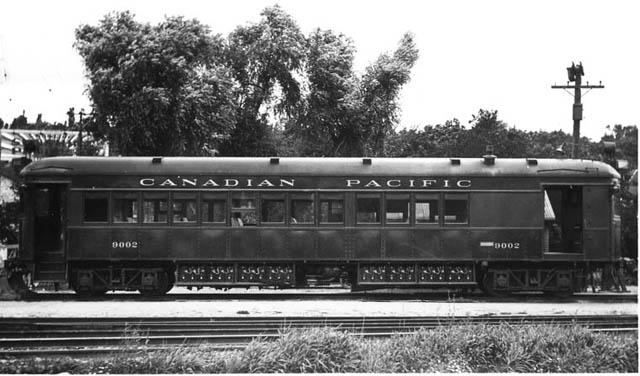
William I. Miller/Collection of William E. Miller
One of the more unusual types of self-propelled passenger
car was the storage battery car. Looking similar to the more conventional
gas-electrics, they were powered by batteries, the electrical power of
which was delivered to the traction motors. Developed in the U.S., they
found favour in short haul branch line service.
Over the years, Canadian Pacific had a variety of self-propelled cars
powered by steam, gas-mechanical, gas-electric, diesel-electric and diesel-mechanical
drive. The 9002 battery car in this photograph (Note: Battery doors
are open) taken in August, 1932 at Guelph, was built early in 1924 by
Canadian Car and Foundry, Canadian Westinghouse and International Equipment
Co. of Montreal, whose president Mr. E.G. Jackson had persuaded the CPR
to try this type of car. The car was originally numbered 45 when built
and was a combine with a baggage compartment and a seating area for 50
passengers. Its length was 53' 2" and it weighed 38 tons. The batteries,
as can be seen in the photograph were contained in under-slung compartments,
the doors of which are open. The life of the batteries was estimated at
three to five years. The car rode on roller bearing journals. The construction
cost was $65,000 including the battery recharging station. The batteries,
which accounted for $25,000 of the cost, required seven to eight hours
to fully charge. The charging time could be split up to two or three different
periods in a 24 hour span. This unit was put into service on the new Hamilton
to Galt run with two trips daily each way on a 90 minute schedule for
the 34 miles.
A demonstration run for civic, business, and railway dignitaries took
place, prior to regular service, on May 17,1924. Prominent among them
were Mayors Jutten of Hamilton, and Willard of Galt, and Mr. H.C. Grout,
General Superintendent of CPR Ontario District (later to become President
of the Soo Line). The trip from Hamilton, up the heavy grade at Waterdown
to Guelph Junction and over the main line to Galt was not hurried, no
attempt being made to keep the scheduled time. Arriving at Galt, the official
party had dinner at Preston Springs, courtesy of the CPR. During this
interlude the batteries were partially charged at the Galt recharging
station. Due to being a half hour behind schedule on arrival, and the
blowing of a fuse, the recharging time was drastically cut, and on departure
at 4:10 p.m. railway officials were concerned whether there would be sufficient
power. However, with efforts to conserve power en route, the 45 arrived
in Hamilton just after 6 p.m. A speed of 40 m.p.h. had been reached which
was considered very good for a car of its type. Thus a new mode of transport
was introduced to the travelling public. By November 1925 car 45 had run
90,000 miles of satisfactory service. Unfortunately the Hamilton-Galt
service did not continue beyond 1926 and car 45 was transferred to the
Guelph Junction-Guelph run, where it was later renumbered to 9002 in 1931.
Not too successful, the power units were removed and the car converted
to a trailer for gas-electric cars around 1941. Probably its last assignment
was on the Fredricton-St. John, New Brunswick run with gas-electric 9007
in 1956. It was scrapped in December, 1958. W.H.N.Rossiter
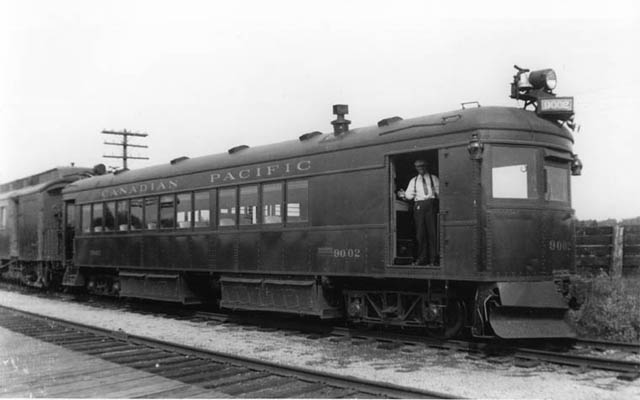
Battery-electric car 9002 with what appears to be a mail
and express car at the junction in 1941. Al Paterson
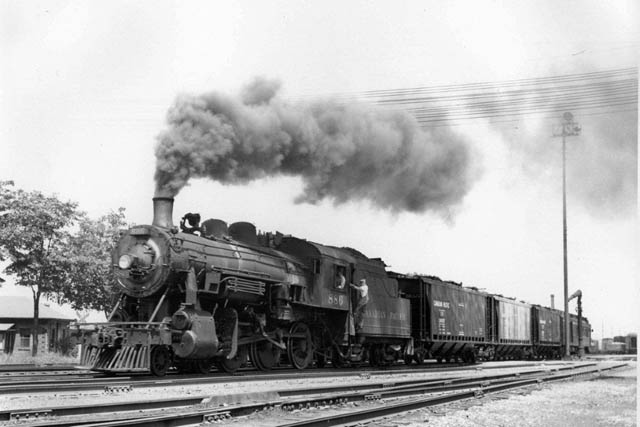
886 with mixed train including some covered hoppers in
St.Marys cement service.
Woodstock 6/56 Bruce Chapman Collection
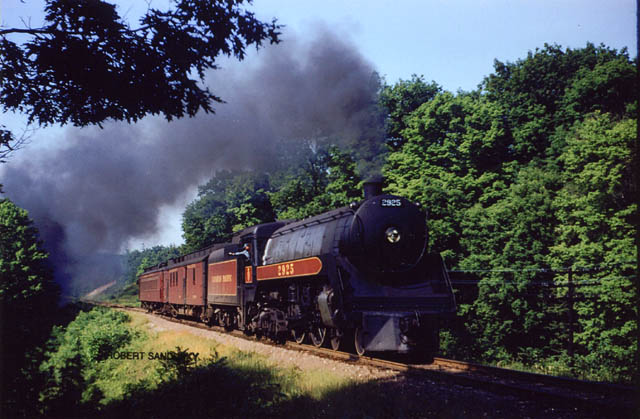
2925 train 637 Hamilton-Goderich approaching Waterdown
just south of Hwy.5
19 June 1954. Photo © Bob Sandusky

Train No. 637 is seen arriving at Guelph Junction from Hamilton
on May 24,1954, at 9:00 a.m. The train will pull ahead to the eastbound
main line of the London Division, cross to the westbound main, back down
west
of the station, turn on the wye facing north and stand behind the station,
awaiting the arrival of Train No. 21,
the Chicago Express. It will depart shortly after, heading for
Guelph and Goderich, returning later in the day
as Train No. 640.
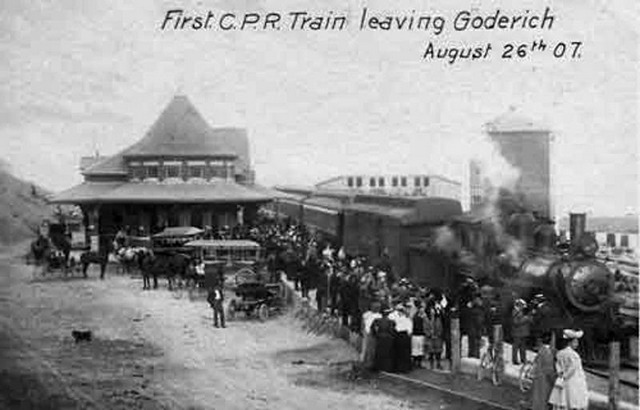
G.W.Thomson & Son
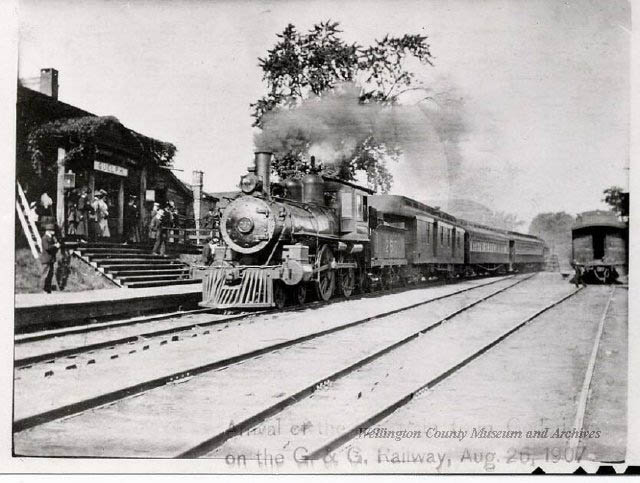
Arrival of the first train from Goderich on the G &
G Railway, August 26, 1907
Wellington County Museum and Archives
Previously, a passenger service from Toronto to Guelph had
been initiated after the opening of the branch from Guelph Junction to
Guelph in 1888. In 1912, the line was built from Hamilton to the Junction,
providing a passenger service from Hamilton to Galt and connections with
the Toronto to Goderich trains. During World War One, the four Goderich
trains were rescheduled and Train Nos. 637 and 640 began running to approximately
the same schedule for the next 39 years. By the mid-1920's, these trains
began operating from Hamilton, and Toronto connections were made with
Train Nos. 21 and 632, the London local. In 1930, there were some 30 passenger
movements per day at the Junction, including the gas-electric turns to
Guelph. In 1935 during the Great Depression the CPR tried to substitute
a bus to Puslinch for the self-propelled car, but was thwarted by the
GJR's directors. The self-propelled car was at one time CP 9002,
a unique battery-electric car, and in later years 9004 a more common gas-electric
car. The Guelph-Guelph Junction service connecting with CPR trains on
the Toronto-Windsor mainline ended April 29, 1961. By 1932, the Goderich
service had been reduced to one train each way (gas-electric for some
years). Trains Nos. 637 and 640 continued until April 23,1955. The next
day, the service was converted to mixed trains, Nos. 683 and 684, later
M741 - M740 -M742, from Guelph to Goderich with a connecting service from
the Junction. On April 27,1958, the shuttle service from the Junction
to Guelph was reduced from six round trips to two per day, cutting the
morning connection for Goderich. These trains were replaced by mixed trains
effective October 26, 1958. By October 30,1960, all Junction connections
were dropped, leaving the Guelph to Goderich mixed trains on their own,
the last ones in southern Ontario, until the last run on Saturday, August
4, 1962 (engine 8144, combine 3313), making the entire line freight only.
Note: All passenger service between Hamilton and Guelph Jct. had
ended in April 1955.

D10g 952 with what appears to be a regular passenger train
which may have been a Goderich train.
Hamilton 1933 Walter Pfefferle Collection

A sense of urgency is evident in this photograph with
the bell caught swinging high on D10 886 with mixed train M683 at West
Monkton. If both trains are on time it is heading for a meet with its
southbound counterpart a few miles away at McNaught at 12.05 P.M. Friday,
September 20, 1957.
Oliver McKee Collection/Courtesy of Paul Charland.
Built in 1890 and still standing on the original site, Guelph Junction
station has always been a train order and register station, and is still
in service. During the passenger era, it furnished a lunch counter service
for connecting passengers. Station Agent, the late Bud Fraser, will always
be remembered by the rail fans of the 1950's as a genial and informative
gentleman willing to help out with word on what steam was coming up the
hill.
No. 2928 was a John Street engine, but when assigned to the Goderich run,
she was maintained at the TH&B Hamilton roundhouse, returning to Toronto
once a month for boiler washouts. Toronto was her home from the time she
was built in March 1938, through to the mid-1950's. When diesels infiltrated
heavily into John Street, No. 2928 was transferred to the New Brunswick
District, and during 1956 to 1957, she was on the St. Andrews mixed train.
Tied Up Serviceable at McAdam, New Brunswick, on March 27, 1958, she was
stored at St. Luc, Montreal by October of that year. She arrived at Angus
Shops on August 31,1959, where she was stored until 1961, when she became
one of 12 steam locomotives presented to the Canadian Railroad Historical
Association by Canadian Pacific. W.H.N.Rossiter
9004 above at Guelph, August 14, 1943. All photographs
by Wm. I .Miller collection of W. E. Miller.
|
|
|
Talk about over-powered! P1 Class 2-8-2 5187 has only a combine
to haul on #342 southbound at Guelph in this October 18, 1958 better
view of the well-kept station. R.J. (Bob) Sandusky
|
This situation existed for just one Time Table (#128
April 27th. 1958), following the reduction from six roundtrips
to two and retirement of the 9004 Gas Car (Doodlebug) often referred
to as "Sparky" for its exhaust.
The next Time Table in October turned the two roundtrips
into Mixed trains! A Daily except Sunday Mixed with an RS-18 diesel
operated from Guelph to Goderich, with an immediate return. Previously
two Mixed trains met halfway between Guelph and Goderich. Prior
to April 24,1955 a roundtrip passenger train operated between
Hamilton and Goderich, Daily except Sunday.
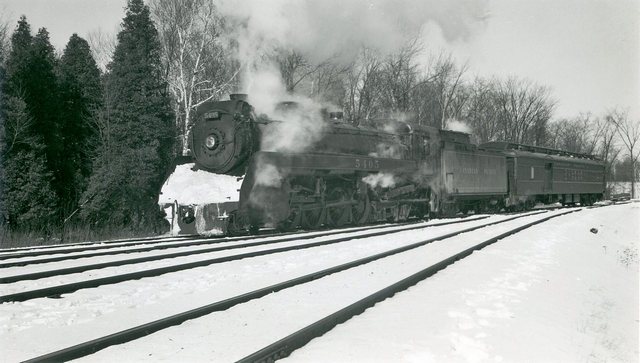
5405 arriving with passenger train 740 from Guelph.
Sat, March 28, 1959. Bud Laws Collection
|

9004 sits at Guelph, Sept. 10,1956, hiding most of the well kept
station next to the Speed River,
between one of its many shuttle runs to Guelph Junction to connect
with CPR Detroit or Toronto trains.
Dave Shaw/collection of Carleton Smith
|
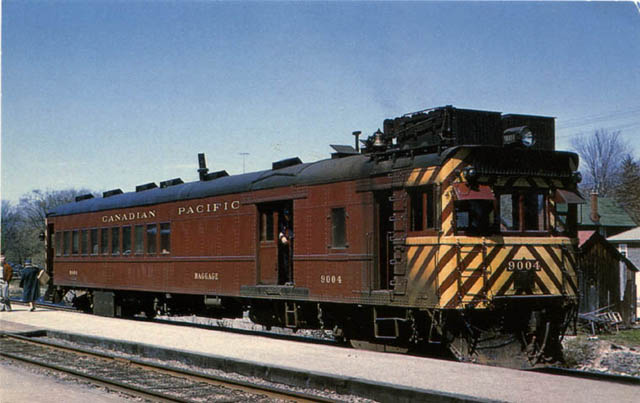
9004 "Sparky" shown here Sat. April 26,1958 on the last
run of train #346 to Guelph Jct. R.J.Sandusky/JBC
Visuals
|
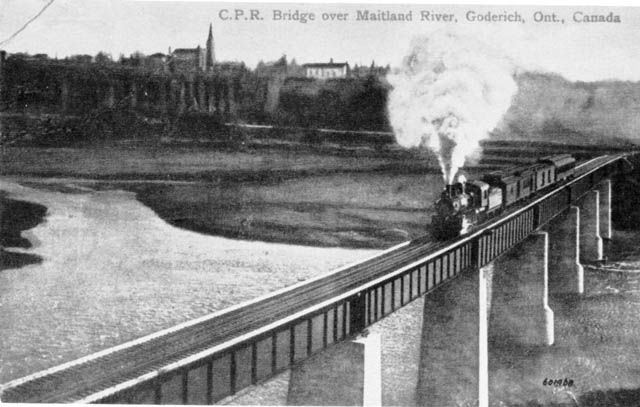
Postcard view of passenger train on spectacular viaduct, circa 1912.
Viaduct has been saved.
Dick George
|
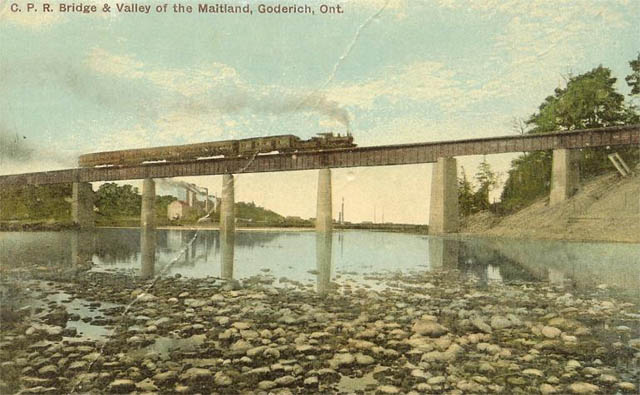
Old post card cancelled May 1923 Collection of Gordon Strathdee
|
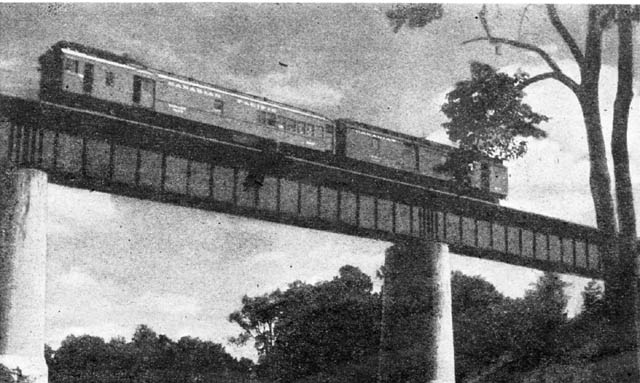
Gas-Electric 9007 with mail and express car on bridge just north
of Wallenstein, Ont.
In a photo by Paul Ziegler published October 1944.
Note: Railway records show 9007 assigned to this Hamilton-Goderich
passenger run
in 1933 and in 1938. It is likely to have been assigned all the
years in between and longer.
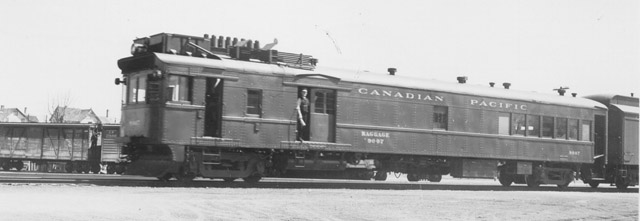
9007 Looks like the trainman is about to toss off some newspapers.
Elmira, Ont. April 26, 1941 Bud Laws Collection
|
|
